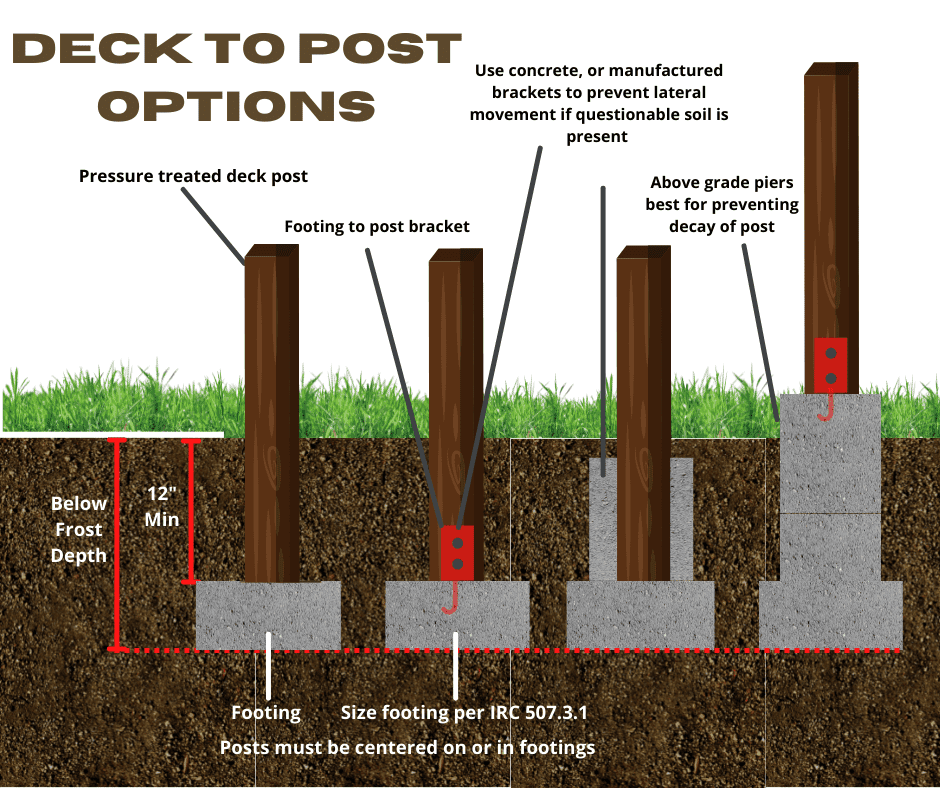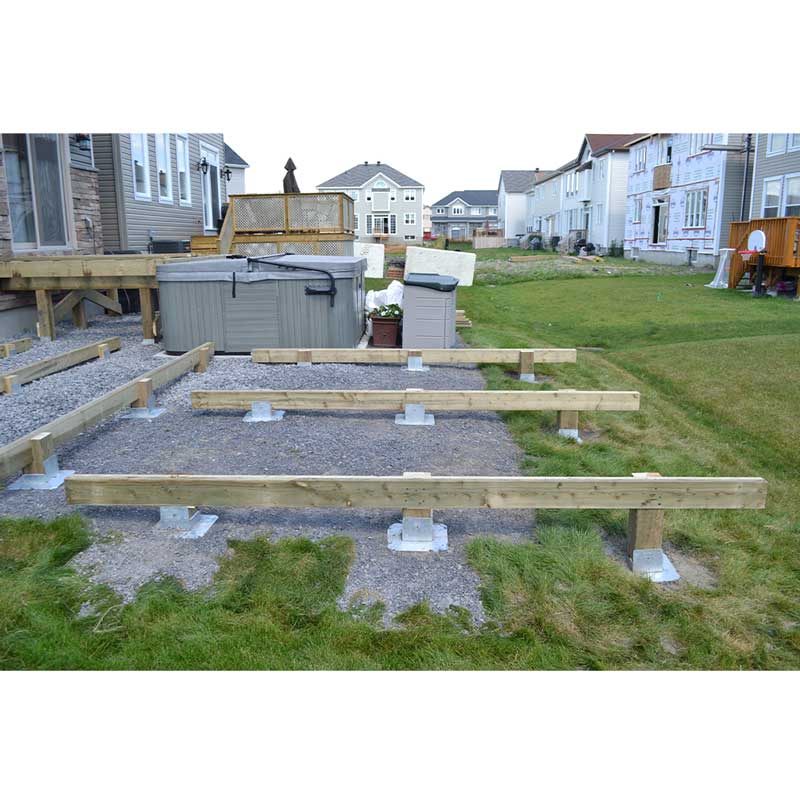Building Security: A Guide to Deck Footings for Your Outdoor Oasis
Improve Your Deck's Security With Appropriate Deck Ground: Make Sure Long-Lasting Durability and Safety
When it concerns developing a deck, guaranteeing its stability and durability is of utmost value. One essential element that usually obtains neglected is the appropriate setup of deck footings. These footings function as the structure of your deck, offering the needed support and stability to hold up against the examination of time. By understanding the impact of soil problems and picking the appropriate materials, you can boost your deck's stability and guarantee its resilient toughness and security. Exactly how exactly do you go about achieving this? In this discussion, we will explore the importance of correct deck ground, overview you through the detailed process of setup, and highlight the significance of regular maintenance to protect your deck's security.
Why Correct Deck Footing Matters
Correct deck footing is vital for ensuring the security and lasting toughness of any type of deck structure. The deck ground, or foundation, works as the anchor point for the entire deck, sustaining the weight of the structure and moving it to the ground below - Deck Footings. Without a solid ground, a deck can end up being unpredictable, leading to architectural failure and prospective safety threats

Additionally, correct deck footing assists to shield against dampness damage. Moisture can leak right into the ground and weaken the foundation, resulting in rotting or degeneration. By making use of appropriate products and techniques for the ground, such as concrete piers or helical heaps, the deck can be raised over the ground, reducing call with wetness and extending its life-span.
Recognizing the Effect of Soil Conditions
The stability and durability of a deck framework can be significantly affected by the dirt problems in which it is built. Recognizing the effect of dirt problems is crucial for ensuring the lasting resilience and safety and security of a deck. Different types of soil have differing load-bearing abilities, drain capacities, and growth and tightening properties, which can all influence the stability of the deck.
One vital variable to consider is the soil's bearing capability, which refers to its capability to support the weight of the deck and any additional loads. Dirts with high bearing capacities, such as compacted crushed rock or clay, are perfect for sustaining hefty structures like decks. On the other hand, soils with reduced bearing abilities, such as loosened sand or soft clay, may call for additional actions to boost security, such as deep footings or dirt stabilization methods.

In addition, the dirt's propensity to increase and get with modifications in dampness web content can impact the stability of the deck. Soils with high clay web content are prone to substantial expansion and contraction, which can lead to settling and shifting of the deck framework. Appropriate measures, such as installing dampness barriers or utilizing alternate structure systems, might be called for to alleviate the impacts of dirt activity.
Choosing the Right Footing Materials
What aspects should be taken into consideration when picking the appropriate ground products for a deck? Selecting the right ground materials is essential for making certain the security and durability of a deck. Several elements require to be taken into consideration when making this decision.
First of all, the sort of soil in the area plays a critical function in identifying the proper ground products. Different soils have differing load-bearing abilities, so it is important to pick products that can sufficiently sustain the weight of the deck and any a knockout post type of potential tons it may bear.
Second of all, the environment and climate condition of the area should be taken into consideration. In locations with extreme winter seasons or high degrees of wetness, footing materials that are resistant to rust and degeneration, such as concrete or treated timber, are advised. These materials are much more durable and much less prone to damage from freezing temperatures, moisture, and parasites.
Furthermore, the dimension and height of the deck likewise influence the option of footing materials. Larger and taller decks call for even more significant grounds to guarantee security and protect against sinking or shifting. In such instances, materials like helical piers or concrete grounds might be extra suitable.
Finally, budget considerations should not be neglected. While some products may offer superior longevity and performance, they may you can find out more additionally feature a greater cost tag. It is essential to strike a balance in between cost and top quality when selecting the proper ground materials for a deck.
Step-by-Step Overview to Setting Up Deck Footings
When mounting deck grounds, it is vital to follow a detailed overview to ensure stability and resilience. By adhering to these actions, you can ensure that your deck will have the ability to hold up against the examination of time and give a delightful and risk-free outside area for many years to find.
The primary step in installing deck grounds is to determine the place and format of your deck. This includes measuring and noting the location where the grounds will be positioned. It is very important to make certain that the grounds are evenly spaced and lined up with the deck's style.
Following, you will certainly require to dig the openings for the footings. The deepness and size of the openings will depend upon the dimension and weight of your deck. It is essential to dig the openings deep sufficient to get to listed below the frost line to protect against frost heave.
As soon as the openings are dug, you can start pouring the concrete grounds. It is recommended to make use of a pre-mixed concrete mix for this action. Fill the openings with concrete, making sure that it is level and smooth. Utilize a message degree to make sure that the grounds are plumb.
After the grounds have been put, permit the concrete to treat for a minimum of 48 hours prior to waging the deck setup. This will certainly guarantee that the footings have solidified and prepare to sustain the weight of the deck.
Normal Upkeep to Preserve Deck Stability
To preserve the security of your deck, normal maintenance is vital. By implementing a routine upkeep schedule, you can make certain that your deck stays risk-free, durable, and visually attractive. One vital facet of upkeep is examining the deck for any type of signs of damage or wear. This consists of monitoring for damaged or loose boards, rusted nails or screws, and any signs of rot or degeneration. It is important to attend to these issues promptly to prevent more damage and possible security dangers.
Cleaning your deck routinely is an additional vital upkeep job. Additionally, on a regular basis applying a protective sealer can help stop moisture damage and prolong the life of your deck.
Along with blog these regular upkeep tasks, it is also recommended to carry out a comprehensive examination of the deck's structural elements a minimum of yearly. This includes checking the problem of the footings, joists, messages, and beams. Any type of indicators of deterioration or weakness need to be dealt with promptly to make certain the continued stability and safety of the deck.
Verdict
In conclusion, proper deck ground is crucial for ensuring the long-lasting longevity and safety and security of your deck. By adhering to a detailed guide to installing deck footings and routinely maintaining them, you can improve your deck's stability.
In this discussion, we will certainly discover the value of correct deck ground, overview you via the step-by-step process of installation, and highlight the relevance of normal upkeep to protect your deck's stability.
Proper deck ground is vital for ensuring the stability and lasting sturdiness of any kind of deck framework.One of the key factors why correct deck ground matters is to prevent the deck from sinking or shifting over time (Deck Footings).In verdict, proper deck ground is vital for making certain the resilient toughness and safety of your deck. By complying with a step-by-step guide to installing deck grounds and regularly keeping them, you can improve your deck's stability